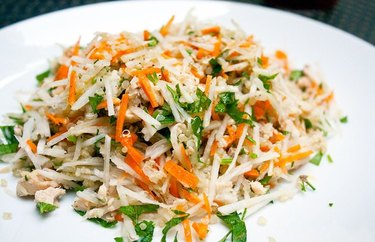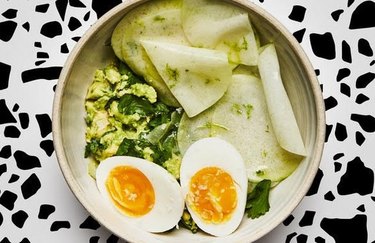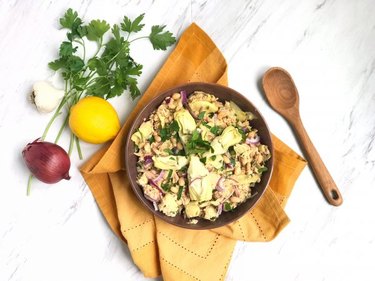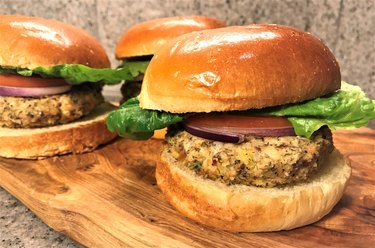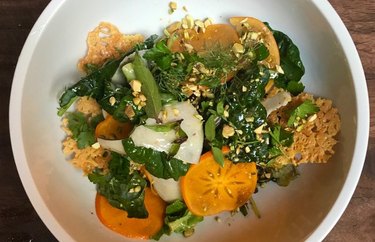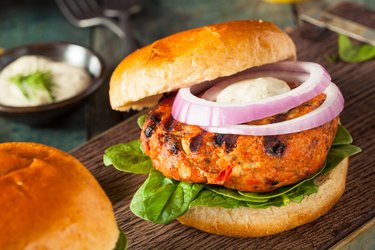
You bought the canned fish — awesome, you're that much closer to getting more omega-3s. The next step: figuring out what to do with it.
Shelf-stable fish is nothing new, but it no longer has to be your last resort for protein in your pantry. Whether you're buying fish in water, oil or with seasonings, here's what to look out for with canned salmon, anchovies and sardines — and then some creative ways to use canned fish.
Video of the Day
Video of the Day
How to Buy Canned Fish
Here's what to consider when buying canned fish:
- Choose BPA-free cans: Most cans now are BPA-free, but it's good to double-check by looking for a BPA-free label.
- Mind the type of oil: If your fish is packed in oil, make sure you're choosing an oil you are comfortable with, such as olive oil. For those allergic to soy, check the label to make sure soy isn't an added ingredient.
- Check for bones: If having the bones in your fish is a no-go, then you might want to choose a different kind. Anchovies often come with bones, but they are not even noticeable. Some sardines have the bones removed, and much of the canned salmon you buy will also have bones. The good news is that all of these bones are edible and a wonderful source of calcium.
- Look for a minimal ingredient list: You can buy canned fish with seasonings or flavors, so always check the ingredient list to ensure you're OK with all of the added flavors.
- Watch for sodium: If you're on a low-sodium diet or just looking to reduce your salt intake, check your food labels to find the brand with the lowest amount of sodium.
Canned Fish Brands We Love
Delicious, High-Protein Canned Fish Recipes
1. Daikon, Salmon and Quinoa Grain Salad
- Protein: 21 grams
Canned salmon is a great choice if you're stocking your pantry. It's extremely versatile and you'll find more ways to eat it than you probably originally thought — or you could eat it plain. Pairing it with a hearty vegetable like daikon and a whole grain makes a complete meal with a lot of protein.
Canned salmon actually has less mercury than fresh or frozen salmon, according to the Food and Drug Administration (FDA). So, if you're pregnant or worried about mercury in your fish, rest assured that you're getting a safer fish.
Get the Daikon, Salmon and Quinoa Grain Salad recipe and nutrition info here.
2. Shaved Vegetable Salad With Sardines
- Protein: 13 grams
Sardines are a fish you either love or hate. Their salty, briny taste adds umami to your favorite dishes, and you may not even realize you're eating fish. This salad is brimming with nutrition, not just from the sardines, but also from hearty root vegetables, sweetness from an apple and healthy monounsaturated fats from the avocado.
Sardines are popular in Mediterranean cooking, so if you're eating more of a plant-based diet, it's the perfect fish to add to your repertoire.
Get the Shaved Vegetable Salad With Sardines recipe and nutrition info here.
3. Spicy Avocado and Anchovy Salad
- Protein: 19 grams
If you're trying to increase the amount of both protein and fiber in your diet, try the combo in this recipe. Canned anchovies and eggs pump up the protein, while the kohlrabi and avocado help you get closer to the recommended amount of fiber.
If kohlrabi is not in your kitchen, you can sub it out for cabbage, broccoli stems or turnips. Study participants who had fiber intakes of at least 25 grams were observed to have lower risks for heart disease, type 2 diabetes and colorectal cancer, a February 2019 study in Lancet found.
Get the Spicy Avocado and Anchovy Salad recipe and nutrition info here.
4. Mediterranean Salmon Salad With Artichokes, White Beans and Lemon Dressing
- Protein: 15 grams
At only 130 calories and 15 grams of protein per serving, you might be asking for seconds. This salad, created by Lauren Harris-Pincus, RD and author of The Protein-Packed Breakfast Club, packs a lot of nutrition. Canned salmon is an excellent way to get omega-3 fatty acids for every member of the family.
Most canned salmon is wild-caught, which is preferable if you eat a lot of salmon, according to the University of California, Berkeley.
Get the Mediterranean Salmon Salad With Artichokes, White Beans and Lemon recipe and nutrition info at Nutrition Starring You.
5. Baked Salmon Burgers
- Protein: 22.5 grams
Salmon burgers are the quintessential canned salmon recipe and this one uses common ingredients you most likely have on hand, like breadcrumbs and Greek yogurt. The total protein in this burger, created by Sarah Koszyk, RD, is about the amount you would get in 3 ounces of ground beef.
Eating meals like this salmon burger are perfect for making sure you get enough protein every day.
Get the Baked Salmon Burgers recipe and nutrition info from Sarah Koszyk.
6. Persimmon, Pistachio and Turnip Salad With Mustard Greens
- Protein: 23 grams
You've probably heard that getting more omega-3 fatty acids in your diet is good for you. Well, adding some sardines to your diet can help.
Ounce for ounce, sardines have more omega-3s than canned tuna, per the National Institutes of Health. Currently, the daily adequate intake for omega-3 fatty acids is 1.1 to 1.6 grams. Three ounces of sardines give you 1.2 grams of a combination of DHA and EPA, two types of omega-3s.
This salad also features persimmons, which are a source of vitamin C, carotenoids and tannins, according to May 2015 research in the Experimental and Clinical Sciences Journal. If you have a hard time finding the fruit out of season, try using an apple to mimic the sweetness of a ripe persimmon.
Get the Persimmon, Pistachio and Turnip Salad With Mustard Greens recipe and nutrition info here.
- Food and Drug Administration: "Mercury Levels in Commercial Fish and Shellfish"
- U.S News and World Report: "Diet Rankings"
- Harvard Medical School: "Should I Be Eating More Fiber?"
- Lancet: "Carbohydrate Quality and Human Health: A Series of Systematic Reviews and Meta-Analyses"
- National Institutes of Health: "Omega-3 Fatty Acids"
- Experimental and Clinical Sciences Journal: "Persimmon (Diospyros kaki) Fruit: Hidden Phytochemicals and Health Claims"
- USDA: "Beef, ground"
- Academy of Nutrition and Dietetics: "How Much Protein Should I Eat?"
- University of California - Berkeley: "Salmon - What's in the Can?"
